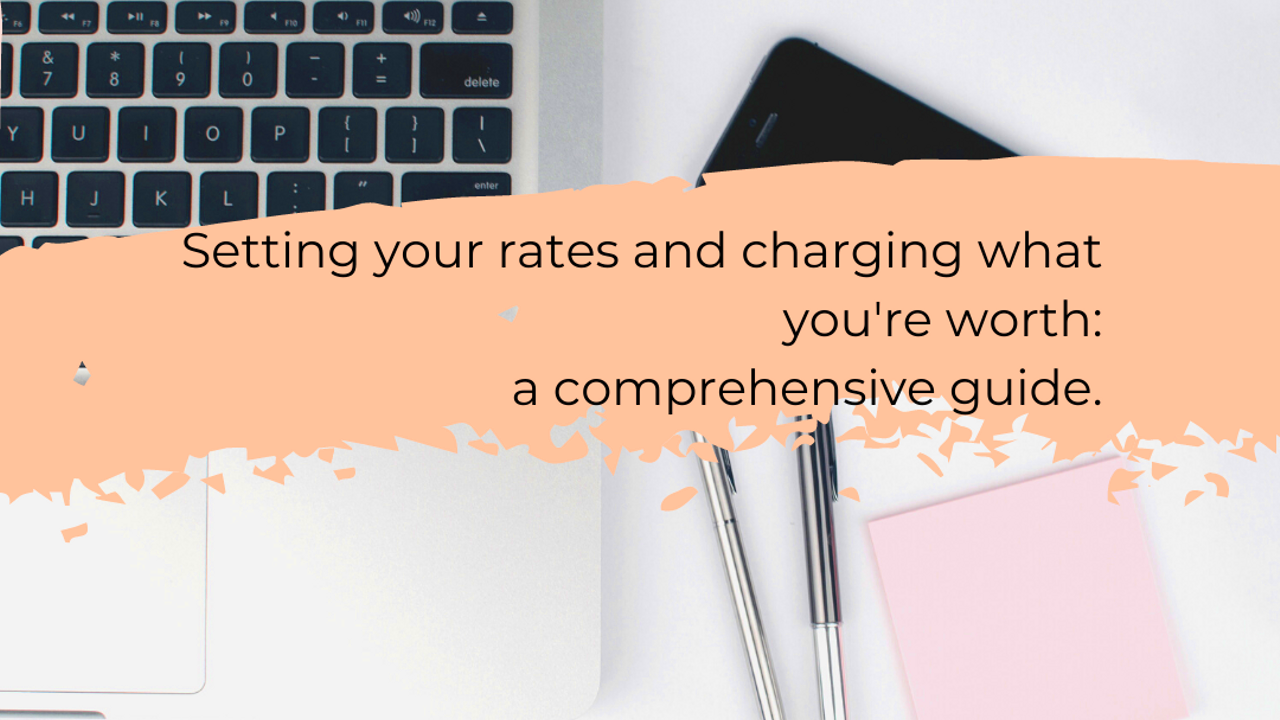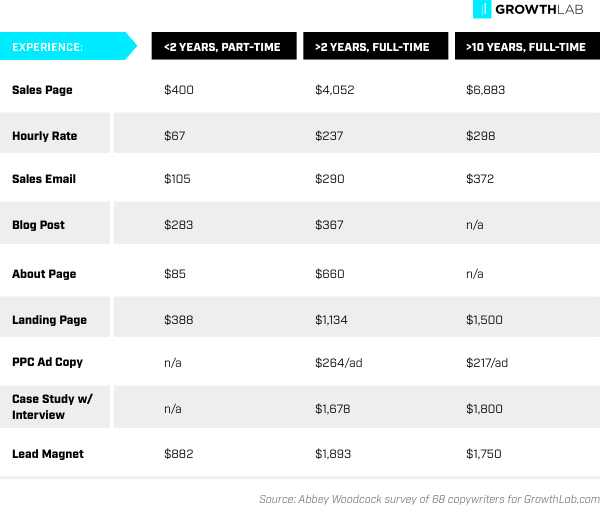Being a freelance writer can be a rewarding profession but determining your rates can be a challenge. I recall feeling overwhelmed when it came to establishing my pricing. The worry of underestimating my worth or deterring potential clients kept me awake at night. Nevertheless grasping the art of pricing your services is essential, for creating a successful business. In this article we’ll explore the factors that impact your rates and provide you with guidance on confidently setting them.
Factors That Influence Copywriting Rates

Determining the appropriate fee as a copywriter entails taking into account various crucial elements. Lets delve deeper into the factors that influence your rates.
- Experience and Expertise: More experienced copywriters can command higher rates. If you’ve been writing for years or have specialized knowledge in a niche, you can charge more.
- Project Complexity: A simple blog post will cost less than a comprehensive white paper. The more complex the project, the higher the rate.
- Client’s Budget: Understanding the client’s budget helps in setting realistic rates. High-budget clients can afford premium services.
- Market Rates: Researching what other freelancers in your field are charging gives you a benchmark. It’s crucial to stay competitive while valuing your work properly.
- Geographic Location: Rates can vary depending on where you and your clients are based. For instance, rates might differ between clients in metropolitan areas and those in smaller towns.
Based on what I’ve seen, a solid approach to determine your value is to begin with a standard rate and then make adjustments based on certain factors. It’s important not to hesitate in reassessing your rates from time to time, especially as you gain more experience or expand your clientele.
Also Read This: How to Edit Fiverr Comments: A Step-by-Step Guide
How to Set Your Rates as a New Freelance Copywriter

If you’re venturing into the world of freelance copywriting it’s crucial to establish rates that not only showcase your expertise but also remain competitive. Here’s a breakdown to assist you in figuring out your pricing.
- Research Industry Standards: Begin by researching what other copywriters with similar experience are charging. Websites like Fiverr or Upwork can give you a rough idea.
- Calculate Your Expenses: Consider your business expenses, such as software subscriptions, marketing costs, and taxes. Ensure your rates cover these costs and leave you with a profit.
- Define Your Niche: If you specialize in a particular industry, such as technology or healthcare, you can charge more due to your specialized knowledge.
- Decide on Pricing Models: Choose a pricing model that works best for you—whether it’s per hour, per project, or a retainer. Each model has its advantages and suits different types of work.
- Start with Introductory Rates: As a newcomer, consider offering slightly lower rates initially to build your portfolio. Once you gain more clients and experience, you can adjust your rates upwards.
- Communicate Clearly: When you pitch your rates to clients, be clear about what’s included. Avoid vague terms and ensure they understand the value you’re providing.
When I first began I offered rates to draw in clients. As I gained experience and self assurance I slowly raised my prices. Its all about evolving and adjusting along the way. Keep in mind that determining your rates isn’t a job; it’s an ongoing process that you’ll fine tune as you progress in your freelancing journey.
Also Read This: How to Work as a Freelance Real Estate Agent
Adjusting Your Rates with Experience
As you progress in freelance copywriting adjusting your fees is crucial for your development. When I began I set my rates unsure of my worth in the industry. However as I refined my abilities and broadened my portfolio I recognized the significance of incorporating that advancement into my pricing. Here are some ways you can tackle this change:
- Track Your Progress: Keep a record of your completed projects and client feedback. As you gather more positive testimonials and successful case studies, it’s a clear sign that your work is valued.
- Evaluate Your Skill Set: Assess any new skills or certifications you’ve acquired. If you’ve mastered SEO, advanced copywriting techniques, or any other specialized area, it’s time to adjust your rates accordingly.
- Consider Market Changes: The market evolves, and so should your rates. Stay updated with industry trends and adjust your pricing to reflect the demand for higher-quality work.
- Increase Gradually: Instead of a significant jump, increase your rates incrementally. This approach helps retain existing clients while attracting new ones willing to pay for premium services.
- Communicate Changes Transparently: Let your clients know about any rate adjustments in advance. Explain the reasons for the increase, highlighting the added value they will receive.
Based on what I’ve seen it’s really important to be bold enough to increase your prices as you advance in your career. It’s not simply a matter of asking for more money but also acknowledging the value of your skills and the excellence of the work you provide.
Also Read This: How to Upload a Photo on Fiverr
Common Pricing Models for Freelance Copywriters
Selecting the pricing structure for your freelance copywriting services can greatly affect your business. Each approach comes with its advantages and is suitable for various project and client types. Lets take a look at some pricing models and their mechanics.
| Pricing Model | Description | Pros | Cons |
|---|---|---|---|
| Hourly Rate | Charging by the hour for the time spent working on a project. |
|
|
| Per Project | Charging a fixed fee for the entire project, regardless of hours spent. |
|
|
| Retainer | Clients pay a regular fee for ongoing access to your services. |
|
|
| Package Pricing | Offering bundled services for a set price. |
|
|
Selecting the appropriate approach hinges on how you like to work, what your clients prefer and the specific needs of the project. In my experience I discovered that blending pricing with a retainer model proved to be effective for my freelance venture. This struck a balance between adaptability and consistency.
Also Read This: Do I Provide Full Broadcast Rights on Fiverr?
How to Communicate Your Rates to Clients
Clearly conveying your pricing to clients is crucial for upholding a professional rapport and preventing any potential miscommunication. Here are some tips on how to articulate your rates with clarity and assurance.
- Be Transparent: Clearly outline what is included in your rate. Whether it’s hourly, per project, or retainer, make sure your clients know exactly what they are paying for.
- Prepare a Pricing Sheet: Create a detailed pricing sheet or proposal that you can share with clients. This should include your rates, services offered, and any additional costs or terms.
- Explain Your Value: When discussing rates, highlight the value you bring to the table. Share your experience, past successes, and how your skills will benefit their project.
- Handle Negotiations Professionally: Be open to discussing rates but do so with confidence. If a client requests a discount, explain how it will affect the scope of work or suggest alternative solutions.
- Document Everything: Always provide written documentation of agreed rates and terms. This avoids any confusion and ensures both parties are on the same page.
Throughout my experience I’ve discovered that effective communication and a pricing document can greatly enhance client interactions. It not helps manage expectations but also fosters trust and professionalism.
Also Read This: How to Find the Best Fiverr Designer
Negotiating Rates and Contracts
One of the challenges in freelancing is negotiating rates and contracts, especially for newcomers. I still recall my initial big negotiation it was like walking on a rope trying to find the balance between valuing my worth and not putting off the client. Here are some tips to help you handle these conversations with assurance.
- Understand Your Worth: Before entering negotiations, be clear about the value you bring to the table. Reflect on your experience, skills, and the results you’ve achieved. Confidence in your worth is key to successful negotiations.
- Know the Client’s Budget: Try to gauge the client’s budget before discussing your rates. This helps you tailor your offer to fit their financial constraints while ensuring you’re fairly compensated.
- Be Prepared to Justify Your Rates: Clients may ask why your rates are what they are. Be ready to explain the factors that contribute to your pricing, such as your expertise, the quality of work, and the time required.
- Offer Flexible Packages: If a client’s budget doesn’t align with your rates, consider offering different packages or adjusting the scope of work. This way, you can still work together while accommodating their budget.
- Draft Clear Contracts: Always have a written contract outlining the project details, deadlines, payment terms, and any other relevant conditions. A well-defined contract helps avoid misunderstandings and protects both parties.
The art of negotiation gets better with time. With increased self assurance and proficiency you’ll discover that navigating these conversations becomes smoother allowing you to obtain a fair reward for your efforts.
Also Read This: How to Post a Project on Fiverr
Managing Your Income and Expenses
Keeping your finances in check as a freelancer demands a blend of self control and systematic planning. I had to face this reality when unforeseen costs came my way and I found it challenging to manage my income. Here are some tips to help you stay on top of your financials,
- Track Your Income: Keep a detailed record of all payments received from clients. Use accounting software or spreadsheets to track your income, which helps in managing cash flow and preparing for tax season.
- Separate Business and Personal Finances: Open a separate bank account for your freelance income and expenses. This makes it easier to track business-related transactions and simplifies tax filing.
- Budget for Expenses: Identify your regular business expenses, such as software subscriptions, office supplies, and marketing costs. Allocate a portion of your income to cover these expenses each month.
- Save for Taxes: Set aside a percentage of your income for taxes. Freelancers need to manage their own tax payments, so having a savings buffer can help avoid last-minute financial stress.
- Review Your Finances Regularly: Periodically review your financial situation to ensure you’re staying within budget and making progress towards your financial goals. Adjust your strategies as needed based on your business performance.
Managing your finances well is key to thriving as a freelancer in the long run. Keeping things in order and taking the initiative can help you keep your business profitable and sustainable.
Also Read This: How to Create a Competitive Fiverr Profile
Frequently Asked Questions
How do I know if my rates are too high or too low?
Look into the norms of your field and see how your charges stack up against those of fellow freelancers in the same area. Getting input from clients or mentors can also help you determine if your rates reflect the quality you offer.
What should I include in a freelance contract?
A freelance agreement should cover aspects like the project scope, expected outcomes, timelines, payment details, revision guidelines and any other relevant terms. This helps establish mutual clarity between you and the client regarding expectations.
How can I manage irregular income as a freelancer?
Establish a savings cushion to support yourself during times of reduced income. Develop a spending plan that factors in variations in your earnings and think about reserving a portion of your income when things are busy to help tide you over during slower periods.
What’s the best way to handle client disputes?
Handle conflicts swiftly and in a manner. Take a look at your agreement to familiarize yourself with the terms and communicate with the client to address any concerns. If needed consider bringing in a mediator or getting legal counsel.
How often should I raise my rates?
Think about increasing your prices every year or when you reach important milestones like finishing a big project or obtaining new qualifications. Continuously assess your rates considering your experience and the current market demand.
Conclusion
Venturing into the realm of freelance copywriting goes beyond mere wordsmithing; it demands a keen awareness of how to establish, negotiate and effectively manage your rates. Speaking from experience I can assure you that the path from determining your rates to fine tuning them as you progress is both tough and fulfilling. Every aspect, from negotiating contracts to handling your finances plays a role in fostering a thriving freelance venture. It's important to remember that your rates should reflect your expertise the caliber of your work and the value you bring to the table. Embrace the learning process and don't hesitate to revise your strategy as you gain more experience and insights. Keep a record of your advancements stay updated on industry benchmarks and always maintain communication with your clients. By doing you'll not enhance your professional standing but also pave the way for a sustainable and rewarding freelance journey.




